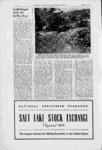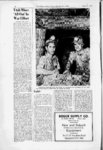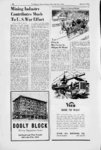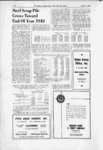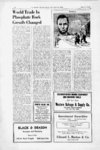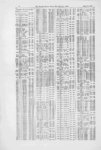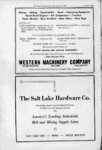| OCR Text |
Show March 5, 1943 'The: Western Mineral Survey, Salt Lake City; Utah 8 Utah Mines All Out In War Effort i (Continued From Page 5) forts to tackle the problem, notably In Senate Bills 40,' 41 and and 42 and 129 and 130. The first three, above named, aimed at restoring block leasing practices to Utah's mining fields something which not only would aid current production, but would also undoubtedly help in the critical development problem have already passed both Senate and House and are assured of becoming law. SBs 129 and 130 would lift for the. duration of the war emergency the restrictions on the length of the working day in underground mines (the famous eight-houlaw) and against the employment of females in mines and smelters. It is believed that some mines could raise their output figures up to SO per cent if the miners were allowed to wxrk up to eight hours in actual mining ' operations, while there are more than 100 mining and smelting jobs Which could be filled during the war emergency by women, not counting, of course, any underground activities, from which . women would still be barred even If SB 130 should pass. These two measures are now in the hands of the Senate sifting committee, both having been reported out favorably 'by the mining and smelting committee of the senior house. One of the problems now being faced! by the metal mining industry is that of the quota system of metal prices, and it is felt that a great many individual readjustments of quotas will have to be made if production is to be at the necessary high level. kept Another similar problem, which also lies in the hands of federal authorities, is that of priorities. At the present time, mine are being adminpriorities istered under a set tof. highly involved rules and regulations that are so , frequently changed that much time, thought and effort is lost by all parties concerned. The practice of granting premium prices for copper, lead and zinc has never had the approval of the metal mining industry, cording to Mr. Mackenzie and the mine operators feel that production would have been Increased and the situation greatly simplified by fixing standard price lev- els at reasonable points and allowing the miner operators to con-duct their business accordingly. The whole dual price and quota system, Mr. Mackenzie considers decidedly inept and disadvantageous to the entire industry. Although production figures for 1942 are not available, it is very obvious that production levels were well maintained by the metalliferous mines and that in e recsome Instances new establishwere ords for output ed," Mr. Mackenzie said. "Under the difficult circumstances,, the results were generally very good and In 1943 every effort is and will be made to meet the demands. However, 1943 production figures will of necessity depend on the circumstances: the available labor, supply and the or lack of restrictions, which will surround it; the ex--, tent that metal prices are adapted to the circumstances which will prevail; the opportunity which is found for new develop-'- , ment work, and many other things. Of one thing we can be sure, however: the metal mining Industry will be 100 per cent in tiie national war effort and doing everything possible to help the march to victory." . collar-to-coll- r ar . - Underground miners like these two Utahns are essential factors in winning the war. With, out strategic metals, we cannot make the weapons for victory. 9,576 ounces from 1941. The Howe output from Utah In 1912, showed a gain of 17 per cerit over 1341. r Sound Co., mining This increase was due partly to ores from its Holden mine the ' increased operations of the in. Chelan County; was again the (Continued From Page 4) Co. The largest gold Utah, opper gold producer in the leading the importance of Baker County producers iii Utah in 1942 were: state, and yielded about 64 per ais a source of metal production Utah Copper Co., at Bingham; the cent of the state total gold in United States Smelting, Refining 1942. Production, principally in 1942. By the end of 1942, most, A Mining Co. (United States A from dry and silidous ores from if not all, of the larger Oregon, the New Park Mining Co., lode mines tn the Republic disLark); gold mines had suspended all proin the Park City region, and the trict, Ferry County, accounted for ductive work as a result of the most of the remainder of the gold Snyder Miiies, Inc., at Mercur. Gold Mining Limitation Order ' The principal gold producing disrecovered in Washington in 1942, tricts were, respectively, the Bingbut showed an aggregate, decrease ham district, the Tintic district of about 8,500 ounces from 1941. Is Gold the SOUTH DAKOTA ' and the Park City region. Host of the placer gold (290 fine The' output WASHINGTON primary metal of value mined in ounces) came from small operations along the Columbia river of recoverable gold was T4,bOu South Dakota.' In 1942 the proof a in ounces' decrease in 1942, fine was Ferry and Stevens Counties. ' duction of recoverable gold 521,989 fine, ounces, a decrease of .78,648 ounces from 1941. Gold in commercial quantities in South Dakota only In the Black Hills area. The Homestake mute 741 WEST 4TH SO. DIAL at Lead, Lawrence County, prothan in lesss FRANK M. LEE. Mgr. gold ducing slightly 1941, continued to- yield the oulk of the gold output of South Da--. kota and was again the largest gold producer in the United States. The second largest gold , MINING AND INDUSTRIAL producer in South Dakota was the Bald Mountain Mining Co. near Trojan, Lawrence County. Gold production n UTAH Utah in 1942 was 386,000 fine ounces, an increase of 29,499 fine Used Us ounces (8 per cent) from 1941. Gold recovered from operations in the ' Bingham district, which represented 83 per cent of the Cold- - copper-gold-silve- . . . : L-20- 8. d BOGUE SUPPLY CO. all-tim- 41 - New and Rebuilt Equipment . See If You Have Equipment For Sale i $ 4 |




